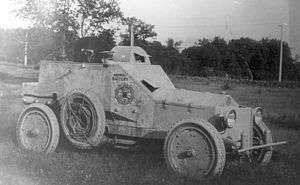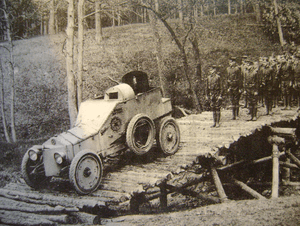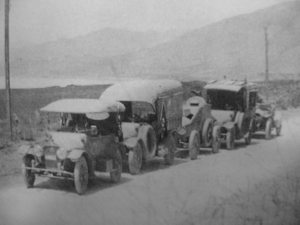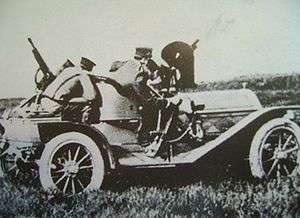Davidson-Cadillac armored car
| Davidson-Cadillac armored car | |
|---|---|
 | |
| Type | Armored car |
| Place of origin | United States |
| Production history | |
| Manufacturer | Northwestern Military and Naval Academy |
| Produced | 1915 |
| Specifications | |
| Crew | driver + 3 |
|
| |
Main armament | M1895 Colt–Browning |
| Engine | petrol |
| Suspension | 4x2 wheel |
| Speed | 70 mph (on-road) |



The Davidson-Cadillac armored car of 1915 was developed on a Cadillac chassis by Royal Page Davidson and the cadets of the Northwestern Military and Naval Academy in Highland Park, Illinois. This military vehicle is the first true fully armored vehicle made in the United States[2] because it was built specifically just for that purpose and was not a conversion of an automobile or truck.[3]
Description
The Davidson car was armor clad around the entire vehicle. It had radiator doors that would open for access and the rear part had an open top, where a machine-gun was mounted just behind the driver.[4]
History
Royal P. Davidson in 1915 commanded a special fleet of eight military vehicles on a convoy from Chicago to San Francisco to evaluate their performance.[5] The vehicles he designed for military use were built by Cadillac.[6] The column included a reconnaissance scout vehicle with instruments for observation, two wireless radio communications vehicles, field cooking vehicle complete with fireless cookers, a hospital vehicle with operating tables and an X-ray machine, a balloon destroyer, a quartermaster's car and the first fully armored military vehicle.[4] War Department personnel representing the government went with the convoy to give reports on the performance of the vehicles.[7] Some of the vehicles had rapid fire machine-guns and searchlights. Five were eight-cylinder vehicles.[8] The Davidson-Cadillac fully armored military vehicle was capable of 70 mph when the roads allowed.[9] It was America's first military fully armored vehicle.[10]
The reconnaissance scout vehicle was equipped with military rifles, map tables, instruments for making maps on the spot, a dictating machine, instruments for observation for seeing behind walls, altitude indicators, and range and elevation finders. The radio wireless communication vehicles came with telescope masts mounted on the running board. They came with generators to generate the normal current of 110 volts. One of these radio vehicles came with a rapid fire Colt automatic machine gun. It also had a powerful electric searchlight with a helograph shutter. The vehicles with the field kitchen and hospital were mounted on an eight-cylinder chassis of a 145 inch wheelbase. Cooking was done using an electric cooker that did not produce any visible fire. The armored vehicle came with bullet-proof steel. It had loopholes for firing out with rifles. It also had a rapid fire Colt automatic machine gun. It came with winch equipment so it could be pulled out of mud. The balloon destroyer vehicle came with a machine gun making it the first American anti-aircraft vehicle.[11]
Davidson had these military vehicles built to convince the government that a mechanized army was the way to go. Davidson and some of his school cadets drove the fully armored vehicle along with seven other support vehicles for 34 days from the Northwestern Military and Naval Academy in the Chicago area to the Panama Pacific Exposition being held in San Francisco in 1915. The first military convoy across the country received much publicity from many newspapers nationwide. The military vehicles were shipped back by train to the Academy in Highland Park when the exposition was over instead of being driven back, since Davidson achieved his goal of demonstrating to the United States Army and the government that a mechanized army was the technology of the future. Davidson's Automobile Corps[12] convoy of the 8 specially designed military vehicles were driven by the cadets of the Northwestern Military Academy as an escort for the Liberty Bell to the Panama Pacific Exposition on the Lincoln Highway in 1915. This was the last time the Liberty Bell traveled from its home for any exposition.[13]
Footnotes
- ↑ Hunnicutt, p. 10 Colonel Davidson's 1909 semi-armored Cadillac. The Colt machine guns have been fitted with high angle mounts for use as a balloon destroyer. No doubt, this was the first American anti-aircraft vehicle. Colonel Davidson was definitely ahead of his time.
- ↑ Chilton, p. 416 This car has the distinction of being the first true armored car built in the United States.
- ↑ "Davidson-Cadillac 1915 Armored Car". Retrieved 2008-12-04.
- 1 2 "American Armoured Cars of WW1 - Part One: Davidson-Cadillacs". Retrieved 2008-12-04.
- ↑ Hunnicutt, p. 10
- ↑ "Cadillac Trivia". Retrieved 2008-12-01.
- ↑ Willcox, p. 40
- ↑ "Cadillac Database - Cadillac Terms and Definitions". Archived from the original on October 3, 2008. Retrieved 2008-12-01.
- ↑ "1943 Cadillac". Retrieved 2008-12-04.
- ↑ "The (new) Cadillac Database". Retrieved 2008-12-04.
- ↑ New York Times - July 18, 1915 - "This Armored Motor Car is now touring across the continent."
- ↑ "Important Facts from the history of Northwestern Military and Naval Academy". Archived from the original on 2007-08-09. Retrieved 2008-12-04.
- ↑ "The Lincoln Highway National Museum & Archives". Retrieved 2008-12-04.
Sources
- American men of mark (1917), A Thousand American Men of Mark Today
- Chilton company (1975), Automotive Industries, Item notes: v.77 1937 Jul-Dec
- Clemens, Al J., The American Military Armored Car, A.J. Clemens, 1969
- Delta Upsilon fraternity (1902), The Delta Upsilon Decennial Catalogue [1903]
- Hunnicutt, R.P., Armored Car: A History of American Wheeled Combat Vehicle, Presido Press (2002), ISBN 0-89141-777-X
- Kane, Joseph Nathan, Famous First Facts - A Record of First Happenings, Discoveries and Inventions in the United States, The H. W. Wilson Company (1950)
- Marquis-Who's Who (1950), Who was who in America. 1943-1950, New Providence, New Jersey
- Marquis-Who's Who (1967), Who was who in America: A Companion Biographical Reference Work to Who's who in America
- Quaife, Milo Milton, Wisconsin: Its History and Its People 1634-1924, Volume 4, S.J. Clarke Publishing Company (1924)
- Randall, Frank Alfred, Randall and Allied Families, Raveret-Weber printing company (1943)
- Stern, Philip Van Doren, A Pictorial History of the Automobile, Viking Press (1953)
- Tucker, Spencer, Tanks: An Illustrated History of Their Impact, ISBN 1-57607-995-3
- Willcox, Cornélis De Witt, The International Military Digest Annual: A Review of the Current Literature of Military Science for 1915-1918, Cumulative Digest Corporation (1916)
External links
- Cadillac Glossary
- Images from Davidson’s trip to the Panama Pacific International Exposition
- History of the Northwestern Military and Naval Academy